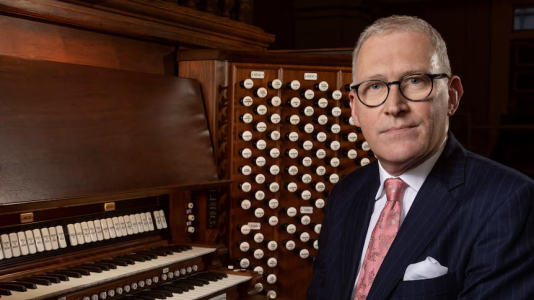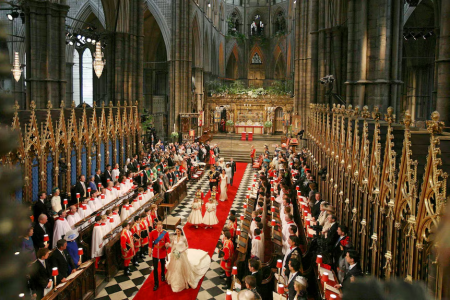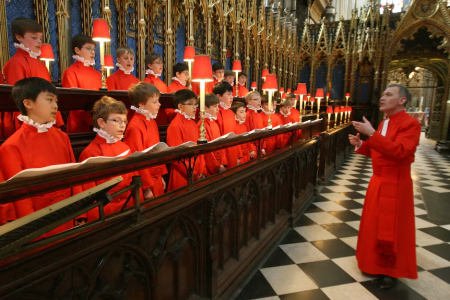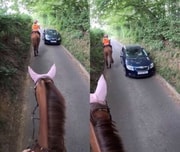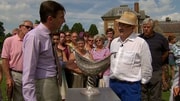Organist James O'Donnell shares what it's like working with the royals at Westminster Abbey
By
ABC News
- Replies 0
Depending on who you ask, the planning for British royal occasions might be the best- or worst-kept secrets in the world.
Some of these plans have been in place for years, even decades.
When James O'Donnell was the Organist and Master of the Choristers of Westminster Abbey, he was involved in the years-long planning of the music for these historic occasions. This included working with composers to write new music for the events.
Currently visiting Australia, O'Donnell reveals some of the behind-the-scenes workings of the royal church, and what it was like when his home turned into a high security zone.
When the Queen Mother, Elizabeth Bowes-Lyon, died in 2002, her funeral was held at the 1000-year-old royal church.
"I've never been involved in anything quite like that," O'Donnell says.
O'Donnell started his role in 2000, and very soon after, the funeral was his first state occasion of international magnitude.
"One had a very strong sense that she represented a whole generation of British life," O'Donnell says.
"It came home to me on that occasion that one day in the distant future, Her Majesty the Queen would die as well."
Queen Elizabeth's funeral planning reportedly began in the 1960s. Despite being involved in organising its music, O'Donnell never thought he would be there to see it through. It turned out to be the last state funeral O'Donnell oversaw.
Part of O'Donnell's job is to identify and work with composers who have been approved to write music for royal occasions.
"Commissioning music cannot be done at the time of a death of a monarch," O'Donnell says. "It's all done very discreetly and there's no guarantee that the music which has been commissioned will be included in the final draft."
O'Donnell did have at least one composer he could rely on, Master of the Queen's music, a position at the time held by British composer Judith Weir.
Weir wrote a new anthem for Elizabeth's funeral, Like As The Hart, alongside another British composer, James McMillan, who wrote Who Shall Separate Us.
One musical choice harked back to Elizabeth's 1952 coronation: Ralph Vaughan Williams's O Taste And See. The piece has become a beloved staple for choirs around the world.
With the Abbey sitting at the heart of London and frequently hosting local and international VIPs, he often had to live with intrusive security measures.
One memorable occasion for O'Donnell was a private memorial service attended by the Queen as well as active members of the British intelligence service.
"I had to be escorted backwards and forwards to my house by a police officer," O'Donnell says.
No member of the congregation was to be photographed and O'Donnell says "nobody was allowed into the sterile area."
"The sterile area was between my office, the choir room and my house [in the precinct of the Abbey]."
"It could be a little inconvenient at times, but I thought that was a small price to pay for the privilege," O'Donnell says.
Sometimes, the rewards outweighed the inconvenience.
The wedding of Prince William to Catherine Middleton, which was watched by more than a billion people worldwide, was one of the highlights of O'Donnell's career.
"There were many discussions as to what music was chosen by the couple and the now king," O'Donnell says.
"It was a very joyful occasion and musically satisfying for the orchestra and choir."
Princess Kate's walk down the aisle of the Westminster Abbey was accompanied by Hubert Parry's I Was Glad. She passed through the musicians who were situated on either side of the aisle on her way to the altar.
"It's a rather archaic job title," O'Donnell says, adding that his role was more focused on rehearsing and conducting the choristers on a day-to-day basis.
Despite its royal status, the Abbey is still a working church.
"We have daily evensong choral services open to the public as well as Sunday services," O'Donnell says, adding televised occasions such as royal weddings and funerals grew out of these daily routines.
Aside from historic state occasions, the Queen, who was the head of the Church of England and a staunch music lover, was often present during many of these services.
"Often when we performed a new commission, [the Queen] would say 'I enjoyed the music'," he says.
"These were often newly created pieces of music that were carefully crafted for [special] occasions, and the Queen's words were much appreciated."
As rewarding as his role was, O'Donnell has enjoyed having more time to spend playing the organ alongside his current teaching position at Yale University in the US.
He has a warm spot for Australia, bringing the Westminster Abbey Choir on tour in 2007. Last year, he gave recitals in Adelaide and Sydney, inaugurating the new organ at Sydney's historic St James King St church.
One of the highlights of O'Donnell's current Australian visit will be playing the Sydney Opera House's Grand Organ. He says it is built differently to a lot of church organs.
"Westminster Abbey organ or St. Paul's Cathedral organ is designed to support worship," O'Donnell says. "They don't overwhelm the choir when they're being played."
The Sydney Opera House's organ, on the other hand, is 15 meters high and 13 meters wide.
"It is the largest mechanical action organ in Australia, [meaning] despite its size, it uses actual levers instead of electricity to operate," O'Donnell explains.
Despite being a fixture of the Concert Hall, the organ is rarely used for solo performances.
"I know what it sounds like and you can hear it online," O'Donnell says. "I've never played it but I'm looking forward to it."
By Ria Andriani
Some of these plans have been in place for years, even decades.
When James O'Donnell was the Organist and Master of the Choristers of Westminster Abbey, he was involved in the years-long planning of the music for these historic occasions. This included working with composers to write new music for the events.
Currently visiting Australia, O'Donnell reveals some of the behind-the-scenes workings of the royal church, and what it was like when his home turned into a high security zone.
Planning the music for royal state occasions
Music plays an integral part in enhancing the splendour of British royalty throughout history, much of which takes place in Westminster Abbey.When the Queen Mother, Elizabeth Bowes-Lyon, died in 2002, her funeral was held at the 1000-year-old royal church.
"I've never been involved in anything quite like that," O'Donnell says.
O'Donnell started his role in 2000, and very soon after, the funeral was his first state occasion of international magnitude.
"One had a very strong sense that she represented a whole generation of British life," O'Donnell says.
"It came home to me on that occasion that one day in the distant future, Her Majesty the Queen would die as well."
Queen Elizabeth's funeral planning reportedly began in the 1960s. Despite being involved in organising its music, O'Donnell never thought he would be there to see it through. It turned out to be the last state funeral O'Donnell oversaw.
Part of O'Donnell's job is to identify and work with composers who have been approved to write music for royal occasions.
"Commissioning music cannot be done at the time of a death of a monarch," O'Donnell says. "It's all done very discreetly and there's no guarantee that the music which has been commissioned will be included in the final draft."
O'Donnell did have at least one composer he could rely on, Master of the Queen's music, a position at the time held by British composer Judith Weir.
Weir wrote a new anthem for Elizabeth's funeral, Like As The Hart, alongside another British composer, James McMillan, who wrote Who Shall Separate Us.
One musical choice harked back to Elizabeth's 1952 coronation: Ralph Vaughan Williams's O Taste And See. The piece has become a beloved staple for choirs around the world.
A small price for privilege
O'Donnell might have had the privilege of being part of the inner workings of royalty, but it did come with a price.With the Abbey sitting at the heart of London and frequently hosting local and international VIPs, he often had to live with intrusive security measures.
One memorable occasion for O'Donnell was a private memorial service attended by the Queen as well as active members of the British intelligence service.
"I had to be escorted backwards and forwards to my house by a police officer," O'Donnell says.
No member of the congregation was to be photographed and O'Donnell says "nobody was allowed into the sterile area."
"The sterile area was between my office, the choir room and my house [in the precinct of the Abbey]."
"It could be a little inconvenient at times, but I thought that was a small price to pay for the privilege," O'Donnell says.
The wedding of Prince William to Catherine Middleton, which was watched by more than a billion people worldwide, was one of the highlights of O'Donnell's career.
"There were many discussions as to what music was chosen by the couple and the now king," O'Donnell says.
"It was a very joyful occasion and musically satisfying for the orchestra and choir."
Princess Kate's walk down the aisle of the Westminster Abbey was accompanied by Hubert Parry's I Was Glad. She passed through the musicians who were situated on either side of the aisle on her way to the altar.
What does the Westminster Abbey Organist actually do?
Ironically for O'Donnell, being the Abbey's Principal organist meant he rarely had the chance to play the organ."It's a rather archaic job title," O'Donnell says, adding that his role was more focused on rehearsing and conducting the choristers on a day-to-day basis.
Despite its royal status, the Abbey is still a working church.
"We have daily evensong choral services open to the public as well as Sunday services," O'Donnell says, adding televised occasions such as royal weddings and funerals grew out of these daily routines.
Aside from historic state occasions, the Queen, who was the head of the Church of England and a staunch music lover, was often present during many of these services.
"Often when we performed a new commission, [the Queen] would say 'I enjoyed the music'," he says.
"These were often newly created pieces of music that were carefully crafted for [special] occasions, and the Queen's words were much appreciated."
He has a warm spot for Australia, bringing the Westminster Abbey Choir on tour in 2007. Last year, he gave recitals in Adelaide and Sydney, inaugurating the new organ at Sydney's historic St James King St church.
One of the highlights of O'Donnell's current Australian visit will be playing the Sydney Opera House's Grand Organ. He says it is built differently to a lot of church organs.
"Westminster Abbey organ or St. Paul's Cathedral organ is designed to support worship," O'Donnell says. "They don't overwhelm the choir when they're being played."
The Sydney Opera House's organ, on the other hand, is 15 meters high and 13 meters wide.
"It is the largest mechanical action organ in Australia, [meaning] despite its size, it uses actual levers instead of electricity to operate," O'Donnell explains.
Despite being a fixture of the Concert Hall, the organ is rarely used for solo performances.
"I know what it sounds like and you can hear it online," O'Donnell says. "I've never played it but I'm looking forward to it."
By Ria Andriani

